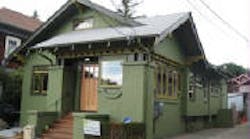BOSTON – David Gottfried, founder of the U.S. Green Building Council, the World Green Building Council and CEO of Regenerative Ventures, has completed the highest scoring green home, leading to a LEED Platinum certification, based on the USGBC LEED for Homes Green Building Rating System that was launched in January 2008.
A unique heating system, using three solar hot water panels manufactured by Suntech and supplied by Hydronic Specialties Co., was installed in the renovated home to preheat the water for Heat Transfer Products’ Phoenix Solar water heater. Other products installed during the home renovation include a Taco X-Pump Block; Myson wall-hung radiators; Solar Thermal Systems solar collectors; Rainwater Hog greywater/rainwater storage systems; Kohler sinks, faucets, showerheads and tub; Caroma dual flush toilets; and Bricor showerheads.
The home received 106.5 points out of 136 possible points under the LEED for Homes certification program. It also received 179 points (the highest score) under the GreenPoint rated Existing Home 1.0 System, a program of Build It Green, a non-profit membership organization whose mission is to promote healthy, energy and resource efficient buildings in California.
The home’s goal is to be a net-zero energy home. Its solar photovoltaic power generation and solar- and hydronic-powered water-heating systems are intended to produce all the energy it needs to operate without drawing from a power grid. If the actual energy contribution isn’t enough to achieve a net zero electricity level, Gottfried says he already has drawn up plans to add more solar.
The Phoenix gas-fired solar water heater unit, Model PH130-80S, is an integral part of the solar and gas powered space-heating and domestic hot water systems in the home. Installed by Sun Light & Power of Berkeley, Calif., the water heater functions as a storage tank for the solar thermal and hydronic heating systems while also providing a high efficiency, gas-fired backup when solar power is not enough to heat the domestic water or the home.
The system works by using solar collection, DHW storage, hydronic space heating and high-efficiency backup. Perched on the home’s roof, three 4x8-ft., flat-plate solar collectors collect energy from the sun. When solar is available, hot fluid from the solar collectors circulates to the Phoenix in the garage, where the heat is transferred to water stored in the water heater’s 130-gal. tank. An external heat exchanger, Taco’s X-Pump Block, maintains a second, closed hot-water loop that sends hot water from the Phoenix storage tank to a series of wall-mounted, high-surface-area Myson wall-hung radiators, located throughout the home.
“To maximize efficiency we oversized the radiators to lower the running temperature of the hydronic system,” said Gary T. Gerber, president of Sun Light & Power. “By allowing for a lower boiler temperature, we increased the utilization capacity of the solar assist to the heating system. Currently the temperature of the boiler is set for 130ºF and this seems to be performing quite well.”
On overcast days or at night, the modulating gas burner inside the Phoenix will fire, providing between 44,000 and 130,000 Btuh of backup water heating for the DHW and space-heating applications. The water stored in the tank is also used for potable hot water applications such as showers, clothes washing and cooking.
“I preferred wall-hung radiators, rather than a conventional, forced-air heating system,” commented Gottfried, whose family of four is now experiencing its first winter in their newly renovated home. “The new system is much quieter, easy to control and improves our air quality by not blowing pollutants throughout the house.
“Each room in the house is a separate zone — eight in all — allowing me to modulate the heating according to the need,” Gottfried added. “In other words, we heat only the bedrooms at night and only the main living areas during the day when we are home,” helping to lower consumption and save energy. Instead of radiators, the kitchen and the main bathroom employ hydronic kick-plate heaters to warm these spaces.
Because sunshine is not the most plentiful from October through February in the Oakland area, the Gottfrieds cannot depend upon solar to make substantial contributions to their home’s space heating during the winter, according to Morgan Muir, whose Oakland-based firm, JTG/Muir, represents both Heat Transfer Products and Solar Thermal Systems.
“While the solar collectors will displace roughly 70% of domestic hot water needed in the Gottfried residence, the system’s space-heating contribution will probably be between 10% and 20%,” commented Muir. “But that, in turn, should translate into a 10-25% annual reduction in space-heating operating costs, and that really helps the economic justification for the Phoenix Solar.
“It’s a balancing act that really comes down to household hot-water usage patterns,” he continued. “For example, a home with teenagers who tend to take long showers will have that much less solar energy to support the space heating. On the other hand, someone who likes to keep room temperatures at 77°F will experience a small solar contribution to domestic hot water.”
Gottfried hopes to control his house better than that though.
To conserve water at the Gottfried home, rainwater is captured and diverted for use in one of the home’s toilets, reducing reliance on potable water supplies. Graywater from the home’s two showers, bathtub and two sinks is used to water the low-water landscaping.
“We have seven Rainwater Hogs capturing rain water, explained Gottfried. “Six of them are used to supply one toilet’s water for around nine months. The other one is on the side of the rear yard office building, and I use it for our small vegetable garden and some other plants.”
The 1,500-sq.ft. house in the Oakland neighborhood of Rockridge, Calif., is half as large as the Gottfrieds previous home in Berkeley Hills, Calif. Gottfried wanted the home to be small to reduce the home’s footprint and show that a family of four can live happily in a smaller space.
“We hoped to showcase how to green an old historic home and still achieve LEED Platinum, as well as downsize 50% for a family of four,” Gottfried said. “Working at home is an added bonus.”
Additional information is available at: www.gottfriedhome.com.


